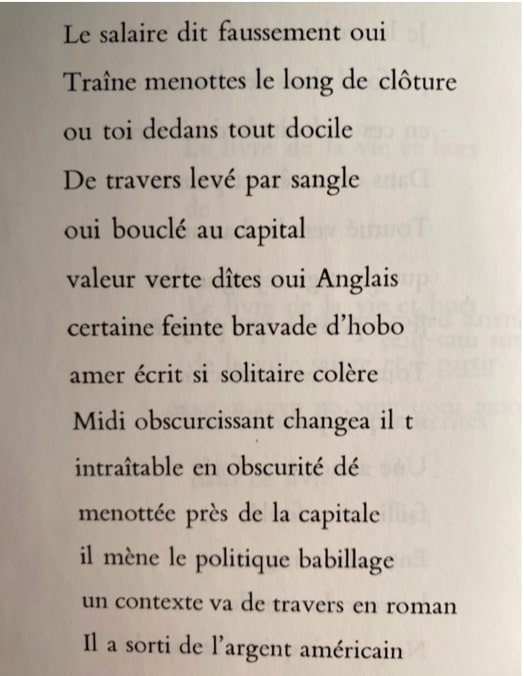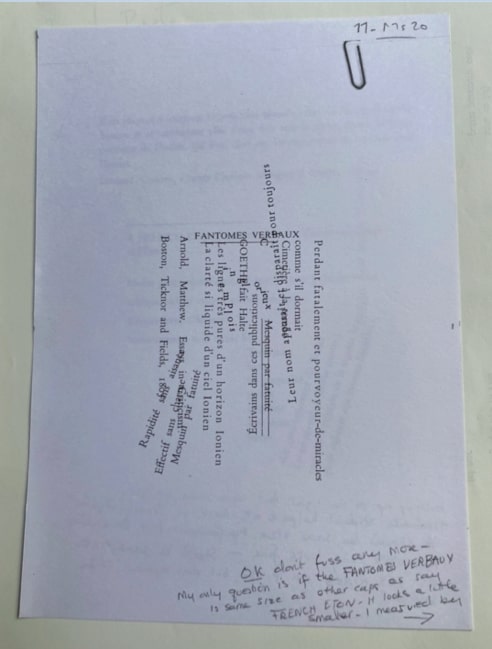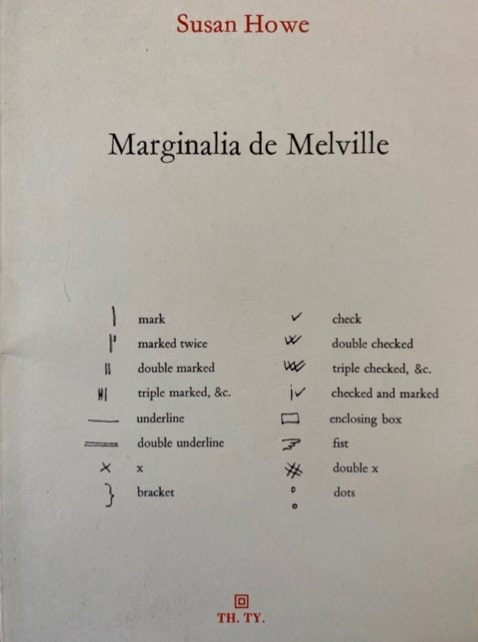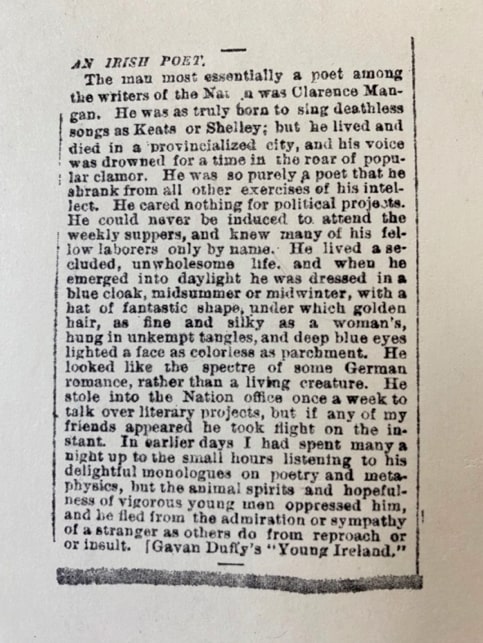“through words of others”: reflections upon the Théâtre Typographique Susan Howe Papers (1997-2013)
From her early wordscapes and watercolor bird collages (c. 1965-72), to her radio programs for WBAI-Pacifica (c. 1977-81) and her 35+ books of poetry and prose since Hinge Picture (Telephone Books, 1974); from her transporting studio recordings and performances with David Grubbs since 2005, residencies (Gardner Museum, 2012), and gallery exhibitions (Yale Union, 2013; Whitney Biennial, 2014) to the multimedia/multisensory adaptations and installations of TOM TIT TOT (MOMA, 2014; Vienna, 2018), Concordance (Grenfell Press, 2019; Berlin, 2022), and “Periscope” (London, 2022), Susan Howe’s generous spirit and collaborative methods transfigure her materials and audiences. This is especially true for the French translations of her works published by Théâtre Typographique between 1997 and 2013.
This brief essay offers reflections upon my recent visits with Bernard Rival and Bénédicte Vilgrain, translators and publishers at their press, Théâtre Typographique (TH. TY.). I’m deeply grateful for the opportunity to study the extensive records of their collaborative work with Susan Howe and their cohort of friends and colleagues involved in the production of the TH. TY. Howe editions: Marginalia de Melville (1997), Deux et (1998), Thorow (2002), Cette île est la mienne (2004), and The Liberties – Pages Manquantes (2013). This essay documents selections from the TH. TY. correspondence, manuscripts, typescripts, and production materials for those volumes. Although these proprietary materials intersect with related TH. TY. records that may be found in the Susan Howe Papers collections at UCSD’s Archive for New Poetry and at Yale University’s Beinecke Library, these more extensive records from the TH. TY. offices have not yet been discussed among Howe’s readers in the US. As such, these ephemeral TH. TY. production records embody a dynamic archive of singular details, collaborative methods, dialogues and disagreements, unresolved questions, and intersecting contingencies/possibilities for these contextually rich transformations of Howe’s works. These exquisite small press volumes from Théâtre Typographique were pivotal for building Howe’s emerging international audience, which has included a community of translators, publishers, readers, and writers since at least the early 1990s.
Susan Howe’s audience in France continues to grow with three outstanding recent editions translated by Antoine Cazé from Ypsilon Éditeur: Il n’y a pas assez de feuilles (2021) / The Europe of Trusts (Sun & Moon, 1990); La marque de naissance (2019) / The Birth-mark (Wesleyan, 1993); and Mon Emily Dickinson (2017) / My Emily Dickinson (North Atlantic, 1985). These are the first complete French translations of these particular volumes. (In 1992, Françoise de Laroque began working on a translation of My Emily Dickinson for P.O.L. (Paul Otchakovsky-Laurens) in dialogue with Dominique Fourcade, but that project was not completed [UCSD Howe Papers, b41.f26].) At the time of this essay’s composition, Cazé’s translation of Spontaneous Particulars (New Directions 2014, 2020) is forthcoming. Although these Ypsilon volumes are significant accomplishments that will surely advance Howe’s international legacy, they stand upon a foundation of French translations first realized by Théâtre Typographique.
Between 1997 and 2013, Vilgrain and Rival translated and published, as noted above, five elegant editions of Howe’s selected works: Marginalia de Melville (1997), Deux et (1998), Thorow (2002), Cette île est la mienne (2004), and The Liberties – Pages Manquantes (2013). These books are currently available via the TH.TY. website, where visitors may also view selected images from each work and their production materials. Compared with the book-length editions from Ypsilon Éditeur, these TH. TY. volumes gather selections from Howe’s previous publications from the US: Marginalia de Melville (1997) includes “Melville’s Marginalia” from The Nonconformist’s Memorial (New Directions, 1993); Deux et (1998) combines “Frame Structures” (New Directions, 1996) with “Sorting Facts” (Wesleyan, 1996); Thorow (2002) combines “Thorow” (Wesleyan, 1990) with “Heliopathy” (TEMBLOR 4, 1986); Cette île est la mienne (2004) combines “Submarginalia” from The Birth-mark (Wesleyan, 1993) with an excerpt from “The Captivity and Restoration of Mrs. Mary Rowlandson” (TEMBLOR 2, 1985); and The Liberties – Pages Manquantes (2013) includes “FRAGMENTS OF A LIQUIDATION,” act “3,” and “H E A R” from The Liberties (Loon Books, 1980; Kulchur Foundation, 1983; Sun & Moon, 1990; NDP, 2002). These five TY. TY. editions offered the first complete French translations of these texts from Susan Howe’s growing list of U.S. publications between 1980 and 2002.
Howe is a poet of swerving reconfigurations; each of her works incorporates materials from earlier and future adjacent projects adapted anew. Her work is always changing, following converging and diverging lines of flight, helical asymptotes. Each of Howe’s individual books is a multiplicity of sequential hybrid forms gathering strophic sonicimagetext assemblages, some previously published in different forms/media, others appearing for the first time while simultaneously always already manifesting elsewhere & otherwise anon (via adaptations, editions, installations, lectures, performances, studio recordings, and webscapes). All of Howe’s works share affinities and echoes beyond anticipation or plan; and yet, each manifestation destabilizes (thereby regenerating) that openwork field of aleatory intersections that also includes each work’s paratextual materials: covers, bookmarks, epigraphs, images, notes, etc. The work(s) escape the work and vice versa on centrifugal and centripetal dimensions.
Through such colliding phenomena, Howe’s factual telepathy/télépathie factuelle transmits “across the moving surface of time, a dark wing the hauntedness all that is in the other stream of consciousness” (Sorting Facts, NDP 7, 15) / “sur la surface mobile du temps une aile sombre la spectralité tout ce qui est dans l'autre courant de conscience” (Deux et 55, 62). With a kindred spirit, the name of Vilgrain’s and Rival’s press, Théâtre Typographique, was inspired by Jacques Pimpaneau’s collection of Chinese ‘shadow’ dolls and by his puppet theatre performances. For Rival and Vilgrain, the polyvocal figure-ground phanopoeia in Howe’s collage poems cast a similar spell. In a 2019 interview, when asked if her multimedia collaborative works take her back, “in new ways, to [her] roots in dramatic performance and visual arts,” Howe reflected that she “think[s] of the space of a page as a stage with word characters moving across” and that “the theatre has always seemed more real than real life” (Howard, Archive and Artifact 213).
These palimpsestic and dramaturgical characteristics are especially true for Howe’s TH. TY. books, all of which emerged from highly collaborative translation and production processes that introduced to each volume (with the exception of Cette île est la mienne) unique paratextual materials not to be found in their English language editions; as such, the TH. TY. volumes adapt and perform Howe’s works anew.
The Liberties – Pages Manquantes (2013) includes translations of Howe’s text by Bernard Rival, letterpress printing by Bénédicte Vilgrain, woodcuts & color prints by Stéphane Bordarier, image production and book design by Michael Woolworth. The resulting work (25 x 26 cm, 56 pages) is a limited-edition artist book of 50 copies, each signed by Howe and Bordarier. The volume’s Garamond type was set by Rival and the letterpress pages were printed in Étais by Vilgrain on Rivoli 120 g. paper. The covers were printed by Woolworth, Rival, and Vilgrain, and the books were bound in Paris by Reliure Houdart.
Thorow (2002) includes translations of Howe’s Thorow and “Heliopathy” by Bernard Rival and translations of selected pages from Howe’s Thorow by Dominique Fourcade. (Although this TH. TY. edition is the first complete and published French translation of this particular text, the UCSD Howe Papers [b43.f9] document an incomplete and unidentified French translation of “Thorow” from 1991.) This TH. TY. trade edition of Thorow in 91 text pages was produced on the offset presses of l’Imprimerie Darantiere in Dijon-Quetigny and includes illustrations from Onondaga or Reminiscences of Earlier and Later Times: Being a series of historical sketches relative to Onondaga; with notes on the several towns in the country, and Oswego; as well as from The Documentary History of the State of New York. The front cover includes an unattributed illustration from Onondaga; the back cover, brief excerpts from Marie-Jean Sauret’s Barca 11 (Paris, 1998) and from Walter Benjamin’s Sur le concept d’histoire (translated by Pierre Rusch, 2000).
Deux et (1998) includes translations of Howe’s “Frame Structures” and “Sorting Facts” by Bénédicte Vilgrain and Bernard Rival along with an annotated selected bibliography/biographical note for Howe that serves as a preface. This TH. TY. trade edition of 109 text pages was also produced on the offset presses of l’Imprimerie Darantiere in Dijon-Quetigny and includes a new arrangement of the photographs that accompany Howe’s 1996 Wesleyan edition of “Sorting Facts” along with an image (of US Navy aircraft) from Chris Marker’s film, Sans Soleil (1983), on the book’s front cover; and on the back cover, a brief translation from one of Charles Olson’s letters (October 1953) to Robert Creeley: “Ce qu’il y a, c’est qu’il est bien difficile, d’être à la fois poète et, historien” / “The thing is, it’s really difficult to be both poet and historian” [Howard retranslation].
These manifold variations in Howe’s texts and accompanying materials assembled in each of these TH. TY. editions emerge from deeply collaborative processes of translation and adaptation during times when Howe, Vilgrain, and Rival shared their materials most often via international post, although some of their communications included e-mails, faxes, and occasional in-person meetings. International post was a lifeline for their work on Marginalia de Melville (1997), Deux et (1998), and Thorow (2002); the TH. TY. Howe papers include approximately 1,600 pages of correspondence documents, manuscripts, typescripts, and production materials for those three volumes. No TH. TY. documents or electronic records survive (at the press offices) from the production processes for Cette île est la mienne (2004) and The Liberties – Pages Manquantes (2013) because those works were assembled via computers that are no longer functioning.
The majority of these TH. TY. Howe papers represent the translation and production processes for Marginalia de Melville( 1997), which has the singular distinction as the first stand-alone publication of Howe’s cross-genre sequential poem, “Melville’s Marginalia.” (All of the works collected in Howe’s Nonconformist’s Memorial (NDP, 1993) appeared previously in journals and/or as chapbooks except for “Melville’s Marginalia.”) The TH. TY. edition of Marginalia de Melville includes translations of Howe’s text by Bénédicte Vilgrain and Bernard Rival with selected passages translated by Dominique Fourcade and Richard Sieburth in dialogue with Susan Howe. (Howe’s collaborative translations of this material with Fourcade go back to 1991; the TH. TY. edition includes those limited passages (page 50 especially) with further corrections from Sieburth via Howe’s correspondence with him during the summer and fall of 1996. In a letter to Howe from 17 June 1996, Vilgrain and Rival suggested that perhaps Fourcade could be persuaded to contribute a brief introduction to Howe’s text, but that possibility was not realized.) Notwithstanding a national truck drivers’ strike in France in November of 1996 that disrupted their workflow, the TH. TY. Howe papers document a vigorous translation process during 1996 and 1997, as in these working pages (NDP 120-121, TH. TY. 43-44) that include Howe’s scrupulous annotations.

After further discussions, drafts, and edits, these resulting translations were published in the TH. TY. edition:


In that same letter (17 June 1996), Rival and Vilgrain addressed Howe’s questions and suggestions for their collaborative process:
“It is very difficult to keep, as you know, sense and form, passing from original to translation. [W]e have tried on some poems as to see what you think and w[h]ether additions (of articles for inst…) or sacrifices to longer or shorten the lines were worth the result. When translated into [F]rench any [E]nglish language text (prose or poem) finds itself longered due to this language that has so few monosyllables, so many mute syllables, so many articles, and no accentuation … The poems in M.M. will suffer such a change (without certitude as to the rich and strange), among others: so any reticence in your part is welcome as a means to keep going … You say and insist that you don’t know [F]rench. But many of your reactions (whether coming from ear or eye… ) are very accute and helping.”
Also in this letter, Vilgrain and Rival shared reflections upon their efforts to accommodate the length of Howe’s lines to their letterpress process via kerning adjustments:
“we will now try as much as possible, given the [F]rench words, articles etc…, to keep the length of the lines as close as we can to the original. But as we compose the texts ourselves with mobile lead types we still can act, at this stage of the work, in the wanted sense by slightly playing (it won’t show) on the spaces between each word, knowing that unlike the types Of the typewriter The typography types all have a different scale! which should altogether shorten all lines.”

In a letter to Philippe Babo (dated 30 September 1996), Rival affirmed Howe’s wishes for their TH. TY. edition: “Susan Howe envisions for this French edition of Melville’s Marginalia the possibility of giving the poem a form closer to that of the manuscript. In the New Directions volume, certain passages were ‘compacted’ together onto the same page for cost reasons, and a few other details were deleted for formatting reasons” [Howard translation]. The resulting TH. TY. trade edition of 82 text pages was letterpress printed by Vilgrain and Rival at their studio in Étais. In order to emulate the collaged formatting and typography of Howe’s manuscripts/typescripts, Rival and Vilgrain took extraordinary measures, sometimes cutting into, filing down, or breaking their lead characters for individual words and/or for intersecting lines in order to render the imbricate ciphers and nested glyphs in Howe’s sonicimagetexts (as in this page, NDP 108, TH. TY. 30).
Marginalia de Melville includes unique paratextual materials in the book’s front and back matter, respectively: photographic reproductions of one passage from Edmund Burke’s writings and of two poems by J. C. Mangan—each photographed text annotated by Herman Melville, illustrating his reading habits. Two additional singular items are to be found on the front and back covers (images below) respectively: Wilson Walker Cowen’s list of symbols used by Melville for annotating his books, and a biographical note on J. C. Mangan from Charles Gavan Duffy’s Young Ireland: a fragment of Irish History, 1840-1850.


Howe was delighted with these new companions for her work. In a letter to Vilgrain and Rival (dated 20 May 1997 from Guilford, CT), she offered these first impressions soon after receiving her copies of the book:
“What can I say! I am so moved. It seems a destiny for the poem I always felt was a book but never until now was in book form … Just looking [at] the book as object which is all I can presently do—the cover is marvelous. The brainstorm of using the piece on the back so casually placed I cannot get over. I am so happy I sent those xeroxed articles though at the time I thought I must be drowning you in useless information. So Melvillian to have a newspaper clipping on the back cover and that passage. You knew as if by telepathy just how right it was … The front cover is perfect. You did those marks amazingly well and having my name in red with your red TH.TY.—lovely. And nice the way the cover brings Cowen into everything immediately. I wonder will people realize what an absolute marvel it is? I do anyway. It is as if you carried the poem beyond merely translating so that it is still open and working as in Billy Budd (an Inside Narrative). There is another narrative—still active—underneath.”
These ephemeral TH. TY. Susan Howe papers, manuscripts, typescripts, and production materials provide expansive documentations of these richly collaborative contexts, paratexts, and subtexts working “through the words of others … from telepathy to poetry” (“Melville’s Marginalia,” NDP 100) / “à travers les mots des autres … de télépathie à poésie” (Marginalia de Melville 16-17).
Acknowledgements
My deepest gratitude to Susan Howe, Bernard Rival, and Bénédicte Vilgrain for their permission to include in this essay the above-noted direct quotations, transcriptions/translations, and photographs from their TH. TY. production materials.
Works Cited
W. Scott Howard. Archive and Artifact: Susan Howe’s Factual Telepathy. Northfield: Talisman House, 2019.
Susan Howe. Sorting Facts; or, Nineteen Ways of Looking at Marker. New Directions Poetry Pamphlet. New York: New Directions, 2013.
——. Deux et. Trans. Bénédicte Vilgrain and Bernard Rival. Courbevoie: Théâtre Typographique, 1998.
——. Marginalia de Melville. Trans. Bénédicte Vilgrain, Bernard Rival, Richard Sieburth, Dominique Fourcade, and Susan Howe. Courbevoie: Théâtre Typographique, 1997.
——. Letter to Bénédicte Vilgrain and Bernard Rival (20 May 1997). Étais: TH. TY. Susan Howe Papers.
——. Marginalia de Melville. Étais: TH. TY. Susan Howe Papers.
——. The Nonconformist’s Memorial. New York: New Directions Publishing, 1993.
Bernard Rival. Letter to Philippe Babo (30 September 1996). Étais: TH. TY. Susan Howe Papers.
Bénédicte Vilgrain and Bernard Rival. Letter to Susan Howe (17 June 1996). Étais: TH. TY. Susan Howe Papers.


